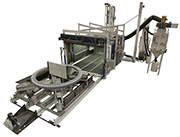E-Archive
Interview
in Vol. 18 - March Issue - Year 2017
Engineering Drives Blasting Industry Forward

Arnie Sallaberry, President of Clemco Industries Corp.

An automated blast room was engineered for surface preparation of 3-metre-diameter yaw drive bearings prior to metal arc spraying. An automated-roller centering system precisely locates parts prior to blasting.

A variable-position nozzle mechanism ensures complete coverage on all sides of the 2300-kg bearing

This automated system tripled production for a steel pipe manufacturer. The cabinet cleans the full 360-degrees of pipe interior in a single pass, processing multiple pipes simultaneously.
MFN Interview with Arnie Sallaberry, President, Clemco Industries Corp.
(?) MFN: Hello, Arnie. It’s been quite a while since we last spoke. What’s going on with Clemco Industries and what changes have you experienced in the market?
(!) A. S.: Yes, Steven; it’s certainly been a while. I think it was 2009. At that time, Clemco and the world were in the grips of the great recession, which saw our revenue drop 25% almost overnight—a scary time. Then, with some creativity and perseverance, from 2010 through 2014, we enjoyed steady increases, which helped us achieve record sales several years in a row. The gains were due to strength in the oil and gas markets and very active U.S. military spending. However, managing that growth on the heels of such a dramatic downturn was overwhelming because there were periods when we were literally swamped with work. Fortunately, our staff responded as they always do, with dedication, sacrifice, long hours and a constant focus on the customer.
Currently, with oil and gas prices muted and military spending all but dried up, we have found new strength over the last couple of years in the industrial markets outside those sectors; markets such as aerospace, automotive, transportation, medical equipment, firearms production, and wind power have shown an eagerness to invest in product improvement and productivity-enhancing upgrades in their blasting processes. Whether it involves enclosing blast operations, automating processes, or simply adding capacity, our customers are continuing to upgrade their capabilities and enhance productivity to compete in this global economy.
(?) MFN: What steps did you take to meet the increased demand in those market sectors?
(!) A. S.: We could see a new economic cycle coming, and we knew we would have to pivot away from our traditional infrastructure and heavy industry customer base. We began to focus not only on technology, new skills, and expanding our already formidable legacy of automation experience, but also on developing new expertise in order to provide unique solutions. We recognized a movement toward automation and equipment that we would specially design and engineer for our customers’ unique requirements. We saw that finishing requirements were becoming more exacting with shorter production cycles.
To meet market demands, over the last four years, we have expanded our engineering department by over 50%, not only increasing headcount but also upgrading our organizational skill levels. We’ve worked hard on upgrading our skilled workforce, both in the plant and in our technical disciplines. We have been updating our knowledge of software, controls, and robotics to enhance our capabilities to provide the new types of solutions our customers are requiring.
These development initiatives have increased our capacity to address those special requirements our customers have and provide creative solutions for their blasting needs. Whether it’s abrasive machining for sound-deadening composite shrouds, stripping titanium extrusions, shot-peening of aluminum stringers or etching of 5 ton yaw bearings for wind tower vanes, Clemco has provided solutions where others have failed. As a result, in the last three years, our sales of non-military specially engineered products have grown by nearly half.
(?) MFN: Seems like a lot to take on. Was it a struggle?
(!) A. S.: Yes, it was extremely challenging. But Clemco associates never back down from a challenge. We are fortunate to enjoy a strong financial position, which proved to be of great benefit at the time in that we could afford to invest in the long term. While ROI considerations are always important, we can adopt a longer-term strategy beyond the typical three-year horizon. Of course, we always try to avoid mistakes, but we know that they are a natural component of the learning process. We make one now and again but it makes us improve. We learn; and our customers never suffer from them.
The most encouraging news is that we now have only scratched the surface of what we can do. We have some great young talent with a few years’ experience under their belts. We have almost a dozen staff members with shot peening certifications; not only in our engineering department and other technical disciplines, but on the plant floor as well. What that means is that we are institutionalizing the tribal knowledge, and indeed, the encyclopedia of an entire industry throughout the Clemco organization. The knowledge is being ingrained in them and is becoming part of our organizational DNA. I am most proud to say that Clemco is becoming a learning organization.
As we are investing in staff development with specialized training, we are beginning to see that customers are coming to us, asking us to collaborate with them not only to help them lean out their blasting/finishing operations but also to ask us for guidance on the intricacies and nuances of blasting, finishing and peening. It’s very exciting and I am so grateful for the efforts expended by our people and the manner in which they have embraced the process.
(?) MFN: What more would you care to tell us about your talent development efforts?
(!) A. S.: Clemco is grooming the next generation of leadership while we infuse the entire organization with the knowledge and experience of our veteran employees. At the same time, the new young people we have brought on board in recent years and continue to hire today, have a natural affinity for technology that our seasoned veterans lack. The young people are using the fruits of their education and the skills they have developed to give us credibility with their young counterparts, who are our customers. There is a much greater interest in technological bells and whistles such as electronic controls, HMI, robotics, automation, material handling, nozzle manipulation, shot flow controls, PLCs, AI, etc. and that interest plays right into the strengths of the younger generations coming into the workforce. Our challenge as managers is to keep them fully engaged and to make sure they know they are heard and that their viewpoint matters while concurrently training them in the core principles of our business and the basic technology of blasting/peening/finishing.
At the moment, Clemco has a great mix of young talent and veterans, who are training and mentoring those young folks. It is a joy to watch and gratifying to see the next generation of Clemco leadership being formed right before my eyes.
(?) MFN: What changes in the industrial markets do you expect in the coming years?
(!) A. S.: Certainly we are already seeing a movement toward greater degrees of automation; for example, collaborative technologies, autonomous robotics, and artificial intelligence. As manufacturing operations continue to be repatriated to the U.S., there is an increasing need for improved productivity, which is being driven, not only to help offset increased labor costs, but also by a need for better repeatability of results from part to part and operation to operation. In addition, the size and scale of these projects seems to be growing, both in complexity and in value.
Another driver in this trend toward automation is a nascent movement to remove the blaster from the blast environment, especially in confined spaces. Clemco has partnered with firms that are developing remote-controlled, programmable and even autonomous technologies to address blasting applications that traditionally have been addressed manually. These developments hold great promise for enhancing operator safety as well as improving productivity. Both of those areas represent philosophies that are at the core of what Clemco has always embodied.
(?) MFN: It’s been great talking to you today. Any parting comments?
(!) A. S.: Well, it’s safe to say that Clemco plans to continue pursuing technological advancements such as those initiatives we’ve discussed. We very much look forward to a growing acceptance of new technology, which we know will move our industry forward. All in all, we are very optimistic about the future.
MFN would like to thank Arnie Sallaberry for this interview!
For Information:
Clemco Industries Corp.
One Cable Car Drive
Washington, Missouri, 63090 USA
Tel. +1. 636.239 0300
E-mail: info@clemcoindustries.com
www.clemcoindustries.com



























